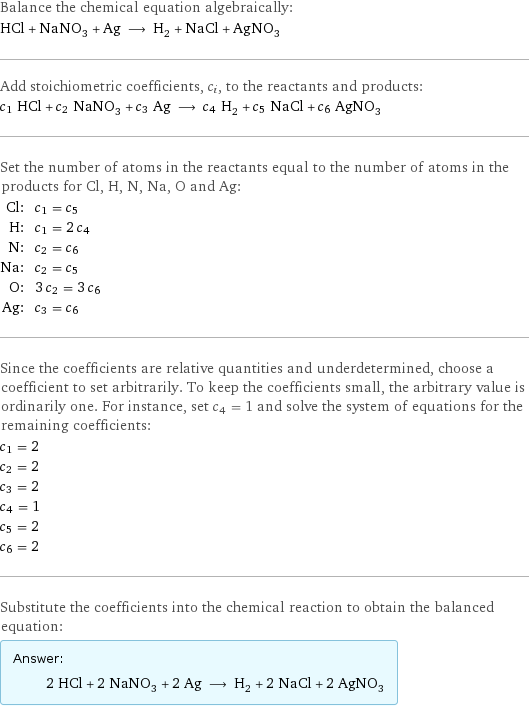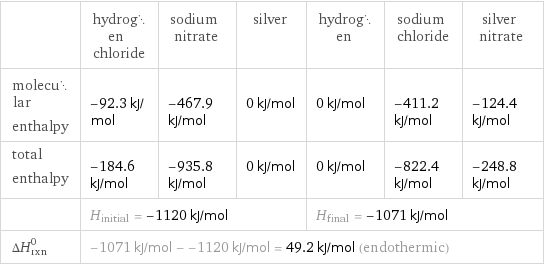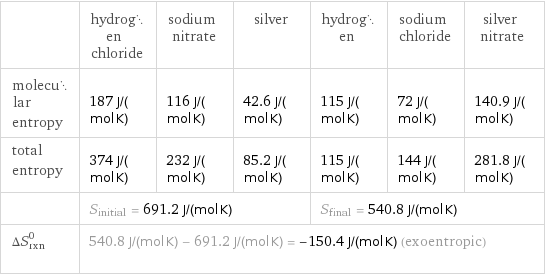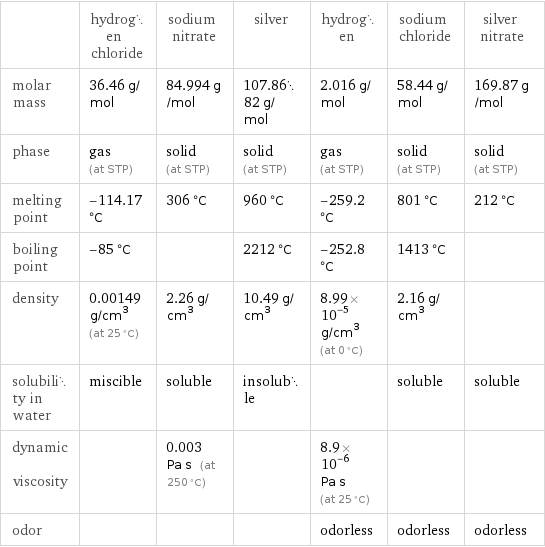Input interpretation

HCl hydrogen chloride + NaNO_3 sodium nitrate + Ag silver ⟶ H_2 hydrogen + NaCl sodium chloride + AgNO_3 silver nitrate
Balanced equation

Balance the chemical equation algebraically: HCl + NaNO_3 + Ag ⟶ H_2 + NaCl + AgNO_3 Add stoichiometric coefficients, c_i, to the reactants and products: c_1 HCl + c_2 NaNO_3 + c_3 Ag ⟶ c_4 H_2 + c_5 NaCl + c_6 AgNO_3 Set the number of atoms in the reactants equal to the number of atoms in the products for Cl, H, N, Na, O and Ag: Cl: | c_1 = c_5 H: | c_1 = 2 c_4 N: | c_2 = c_6 Na: | c_2 = c_5 O: | 3 c_2 = 3 c_6 Ag: | c_3 = c_6 Since the coefficients are relative quantities and underdetermined, choose a coefficient to set arbitrarily. To keep the coefficients small, the arbitrary value is ordinarily one. For instance, set c_4 = 1 and solve the system of equations for the remaining coefficients: c_1 = 2 c_2 = 2 c_3 = 2 c_4 = 1 c_5 = 2 c_6 = 2 Substitute the coefficients into the chemical reaction to obtain the balanced equation: Answer: | | 2 HCl + 2 NaNO_3 + 2 Ag ⟶ H_2 + 2 NaCl + 2 AgNO_3
Structures

+ + ⟶ + +
Names

hydrogen chloride + sodium nitrate + silver ⟶ hydrogen + sodium chloride + silver nitrate
Reaction thermodynamics
Enthalpy

| hydrogen chloride | sodium nitrate | silver | hydrogen | sodium chloride | silver nitrate molecular enthalpy | -92.3 kJ/mol | -467.9 kJ/mol | 0 kJ/mol | 0 kJ/mol | -411.2 kJ/mol | -124.4 kJ/mol total enthalpy | -184.6 kJ/mol | -935.8 kJ/mol | 0 kJ/mol | 0 kJ/mol | -822.4 kJ/mol | -248.8 kJ/mol | H_initial = -1120 kJ/mol | | | H_final = -1071 kJ/mol | | ΔH_rxn^0 | -1071 kJ/mol - -1120 kJ/mol = 49.2 kJ/mol (endothermic) | | | | |
Entropy

| hydrogen chloride | sodium nitrate | silver | hydrogen | sodium chloride | silver nitrate molecular entropy | 187 J/(mol K) | 116 J/(mol K) | 42.6 J/(mol K) | 115 J/(mol K) | 72 J/(mol K) | 140.9 J/(mol K) total entropy | 374 J/(mol K) | 232 J/(mol K) | 85.2 J/(mol K) | 115 J/(mol K) | 144 J/(mol K) | 281.8 J/(mol K) | S_initial = 691.2 J/(mol K) | | | S_final = 540.8 J/(mol K) | | ΔS_rxn^0 | 540.8 J/(mol K) - 691.2 J/(mol K) = -150.4 J/(mol K) (exoentropic) | | | | |
Equilibrium constant
![Construct the equilibrium constant, K, expression for: HCl + NaNO_3 + Ag ⟶ H_2 + NaCl + AgNO_3 Plan: • Balance the chemical equation. • Determine the stoichiometric numbers. • Assemble the activity expression for each chemical species. • Use the activity expressions to build the equilibrium constant expression. Write the balanced chemical equation: 2 HCl + 2 NaNO_3 + 2 Ag ⟶ H_2 + 2 NaCl + 2 AgNO_3 Assign stoichiometric numbers, ν_i, using the stoichiometric coefficients, c_i, from the balanced chemical equation in the following manner: ν_i = -c_i for reactants and ν_i = c_i for products: chemical species | c_i | ν_i HCl | 2 | -2 NaNO_3 | 2 | -2 Ag | 2 | -2 H_2 | 1 | 1 NaCl | 2 | 2 AgNO_3 | 2 | 2 Assemble the activity expressions accounting for the state of matter and ν_i: chemical species | c_i | ν_i | activity expression HCl | 2 | -2 | ([HCl])^(-2) NaNO_3 | 2 | -2 | ([NaNO3])^(-2) Ag | 2 | -2 | ([Ag])^(-2) H_2 | 1 | 1 | [H2] NaCl | 2 | 2 | ([NaCl])^2 AgNO_3 | 2 | 2 | ([AgNO3])^2 The equilibrium constant symbol in the concentration basis is: K_c Mulitply the activity expressions to arrive at the K_c expression: Answer: | | K_c = ([HCl])^(-2) ([NaNO3])^(-2) ([Ag])^(-2) [H2] ([NaCl])^2 ([AgNO3])^2 = ([H2] ([NaCl])^2 ([AgNO3])^2)/(([HCl])^2 ([NaNO3])^2 ([Ag])^2)](../image_source/56eaa3ecdfe124f15f0b7900c2e136f5.png)
Construct the equilibrium constant, K, expression for: HCl + NaNO_3 + Ag ⟶ H_2 + NaCl + AgNO_3 Plan: • Balance the chemical equation. • Determine the stoichiometric numbers. • Assemble the activity expression for each chemical species. • Use the activity expressions to build the equilibrium constant expression. Write the balanced chemical equation: 2 HCl + 2 NaNO_3 + 2 Ag ⟶ H_2 + 2 NaCl + 2 AgNO_3 Assign stoichiometric numbers, ν_i, using the stoichiometric coefficients, c_i, from the balanced chemical equation in the following manner: ν_i = -c_i for reactants and ν_i = c_i for products: chemical species | c_i | ν_i HCl | 2 | -2 NaNO_3 | 2 | -2 Ag | 2 | -2 H_2 | 1 | 1 NaCl | 2 | 2 AgNO_3 | 2 | 2 Assemble the activity expressions accounting for the state of matter and ν_i: chemical species | c_i | ν_i | activity expression HCl | 2 | -2 | ([HCl])^(-2) NaNO_3 | 2 | -2 | ([NaNO3])^(-2) Ag | 2 | -2 | ([Ag])^(-2) H_2 | 1 | 1 | [H2] NaCl | 2 | 2 | ([NaCl])^2 AgNO_3 | 2 | 2 | ([AgNO3])^2 The equilibrium constant symbol in the concentration basis is: K_c Mulitply the activity expressions to arrive at the K_c expression: Answer: | | K_c = ([HCl])^(-2) ([NaNO3])^(-2) ([Ag])^(-2) [H2] ([NaCl])^2 ([AgNO3])^2 = ([H2] ([NaCl])^2 ([AgNO3])^2)/(([HCl])^2 ([NaNO3])^2 ([Ag])^2)
Rate of reaction
![Construct the rate of reaction expression for: HCl + NaNO_3 + Ag ⟶ H_2 + NaCl + AgNO_3 Plan: • Balance the chemical equation. • Determine the stoichiometric numbers. • Assemble the rate term for each chemical species. • Write the rate of reaction expression. Write the balanced chemical equation: 2 HCl + 2 NaNO_3 + 2 Ag ⟶ H_2 + 2 NaCl + 2 AgNO_3 Assign stoichiometric numbers, ν_i, using the stoichiometric coefficients, c_i, from the balanced chemical equation in the following manner: ν_i = -c_i for reactants and ν_i = c_i for products: chemical species | c_i | ν_i HCl | 2 | -2 NaNO_3 | 2 | -2 Ag | 2 | -2 H_2 | 1 | 1 NaCl | 2 | 2 AgNO_3 | 2 | 2 The rate term for each chemical species, B_i, is 1/ν_i(Δ[B_i])/(Δt) where [B_i] is the amount concentration and t is time: chemical species | c_i | ν_i | rate term HCl | 2 | -2 | -1/2 (Δ[HCl])/(Δt) NaNO_3 | 2 | -2 | -1/2 (Δ[NaNO3])/(Δt) Ag | 2 | -2 | -1/2 (Δ[Ag])/(Δt) H_2 | 1 | 1 | (Δ[H2])/(Δt) NaCl | 2 | 2 | 1/2 (Δ[NaCl])/(Δt) AgNO_3 | 2 | 2 | 1/2 (Δ[AgNO3])/(Δt) (for infinitesimal rate of change, replace Δ with d) Set the rate terms equal to each other to arrive at the rate expression: Answer: | | rate = -1/2 (Δ[HCl])/(Δt) = -1/2 (Δ[NaNO3])/(Δt) = -1/2 (Δ[Ag])/(Δt) = (Δ[H2])/(Δt) = 1/2 (Δ[NaCl])/(Δt) = 1/2 (Δ[AgNO3])/(Δt) (assuming constant volume and no accumulation of intermediates or side products)](../image_source/9cc0e5b6acff653f1e780dfe6079f568.png)
Construct the rate of reaction expression for: HCl + NaNO_3 + Ag ⟶ H_2 + NaCl + AgNO_3 Plan: • Balance the chemical equation. • Determine the stoichiometric numbers. • Assemble the rate term for each chemical species. • Write the rate of reaction expression. Write the balanced chemical equation: 2 HCl + 2 NaNO_3 + 2 Ag ⟶ H_2 + 2 NaCl + 2 AgNO_3 Assign stoichiometric numbers, ν_i, using the stoichiometric coefficients, c_i, from the balanced chemical equation in the following manner: ν_i = -c_i for reactants and ν_i = c_i for products: chemical species | c_i | ν_i HCl | 2 | -2 NaNO_3 | 2 | -2 Ag | 2 | -2 H_2 | 1 | 1 NaCl | 2 | 2 AgNO_3 | 2 | 2 The rate term for each chemical species, B_i, is 1/ν_i(Δ[B_i])/(Δt) where [B_i] is the amount concentration and t is time: chemical species | c_i | ν_i | rate term HCl | 2 | -2 | -1/2 (Δ[HCl])/(Δt) NaNO_3 | 2 | -2 | -1/2 (Δ[NaNO3])/(Δt) Ag | 2 | -2 | -1/2 (Δ[Ag])/(Δt) H_2 | 1 | 1 | (Δ[H2])/(Δt) NaCl | 2 | 2 | 1/2 (Δ[NaCl])/(Δt) AgNO_3 | 2 | 2 | 1/2 (Δ[AgNO3])/(Δt) (for infinitesimal rate of change, replace Δ with d) Set the rate terms equal to each other to arrive at the rate expression: Answer: | | rate = -1/2 (Δ[HCl])/(Δt) = -1/2 (Δ[NaNO3])/(Δt) = -1/2 (Δ[Ag])/(Δt) = (Δ[H2])/(Δt) = 1/2 (Δ[NaCl])/(Δt) = 1/2 (Δ[AgNO3])/(Δt) (assuming constant volume and no accumulation of intermediates or side products)
Chemical names and formulas

| hydrogen chloride | sodium nitrate | silver | hydrogen | sodium chloride | silver nitrate formula | HCl | NaNO_3 | Ag | H_2 | NaCl | AgNO_3 Hill formula | ClH | NNaO_3 | Ag | H_2 | ClNa | AgNO_3 name | hydrogen chloride | sodium nitrate | silver | hydrogen | sodium chloride | silver nitrate IUPAC name | hydrogen chloride | sodium nitrate | silver | molecular hydrogen | sodium chloride | silver nitrate
Substance properties

| hydrogen chloride | sodium nitrate | silver | hydrogen | sodium chloride | silver nitrate molar mass | 36.46 g/mol | 84.994 g/mol | 107.8682 g/mol | 2.016 g/mol | 58.44 g/mol | 169.87 g/mol phase | gas (at STP) | solid (at STP) | solid (at STP) | gas (at STP) | solid (at STP) | solid (at STP) melting point | -114.17 °C | 306 °C | 960 °C | -259.2 °C | 801 °C | 212 °C boiling point | -85 °C | | 2212 °C | -252.8 °C | 1413 °C | density | 0.00149 g/cm^3 (at 25 °C) | 2.26 g/cm^3 | 10.49 g/cm^3 | 8.99×10^-5 g/cm^3 (at 0 °C) | 2.16 g/cm^3 | solubility in water | miscible | soluble | insoluble | | soluble | soluble dynamic viscosity | | 0.003 Pa s (at 250 °C) | | 8.9×10^-6 Pa s (at 25 °C) | | odor | | | | odorless | odorless | odorless
Units
